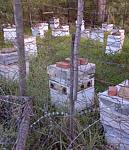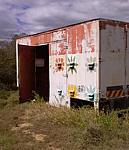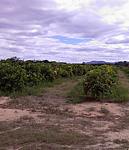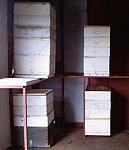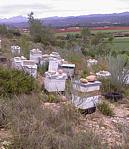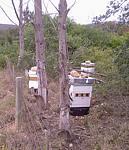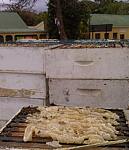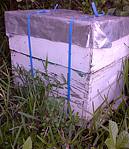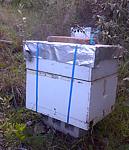Keokama Apiaries.
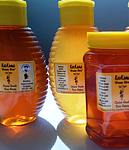 Honey - Nature’s sweet medicine! - CLICK HERE
Honey - Nature’s sweet medicine! - CLICK HERE
Keokama "Honey River" Putting Health back into Honey
What does Keokama do that makes their honey healthy?
1. Treatment of hives:
Over 90 % of commercial beekeepers treat their hives with Waksol or Creosote to preserve the wood. These substances are poisonous to humans and on a hot day the treated wood gives off an oily residue. Waksol cannot be painted over and the continuous passage of millions of tiny feet over them must carry minute particles onto the combs inside the hive. These are the combs that honey is then extracted from!
At Keokama the outside of the hives are painted with a non-toxic paint and the interiors are treated with a mixture of beeswax and propolis, products with tremendous health value produced by the bees themselves. Although the idea appears commercially and not financially viable because of the amount of labor and the value of propolis, we feel that honey is a health product and should be handled as naturally as possible.
2. Crop honey:
All agricultural crops are treated or sprayed and are the main source for the bulk of the honey produced in this country. Honey is a scarce commodity and most large-scale dealers will buy from other sources, which includes importing honey from overseas.
The only commercial crop that Keokama uses for honey production is citrus. Our apiary sites are all located on large citrus estates, which belong to personal friends. Every year before the citrus season we meet with them to discuss the coming seasons spraying program and by arrangement all crop spraying is done from midnight to 4 am. This ensures that minimal residues are taken back to the hives. We continue to try and educate landowners as to the value of bees to their citrus crop and ways to minimize bee poisoning.
3. Organic honey:
Keokama Apiaries have started to ensure the production of a true indigenous organic honey. An apiary site has been established that has no agricultural lands within an 8-kilometer radius so there is no chance of the bees coming into contact with any nectar source other than indigenous flower sources. There is no possibility of the honey being polluted by any source. The production costs of this type of honey, due to the much lower carrying capacity, are substantially higher than crop honey. The cost of this honey will be higher but health wise there is no competition. Due to our hive treatment we can truly claim this as organic honey.
4. Treatment of honey:
Most commercial operations heat treat honey to prevent crystallization. This destroys the food value of honey and negates the health value of the honey. Crystallization doesn’t mean that the honey has gone off but is a sign of pure untreated honey.
“Raw honey” is untreated honey and all of our honey qualifies as “raw honey”.
5. Imported honey:
A lot of large scale honey suppliers and the big food chains all sell imported honey. The law quite clearly states that all imported honey must be labeled as such, clearly stating country of origin as well as display the radiated logo. The logo must have lettering no less than 3 mm in height. Look at the bottom corner of the back label and you will see a tiny logo, which looks like a cloverleaf. This is because the imported honey has to be treated with radium to prevent the accidental import of diseases.
6. Hygiene standards
Keokama apiaries maintain the highest hygiene standards in their Honey room and all surfaces are spotless and cleaned every time bottling is finished.
Honey - Nature’s sweet medicine!
Honey is the oldest sweetener known to man and is also attributed with the most healing properties. Bees make honey naturally from the nectar of flowers and plant secretions.
Honey contains glucose, fructose, small quantities of saccharose and many other active ingredients. Honey is more than just sugar it contains more than 70 bioactive substances. Most come from nectar and some from the hypo pharyngeal glands of bees such as antibacterial inhibins and enzymes. Inhibins give honey its bactericidal properties but they are thermolabile and photolabile [destroyed by heat and light].
The clearer and more fluid honey is, the more likely it is to have been industrially processed and adulterated.
Crystallization of honey is a guarantee of its quality and purity. Honey which doesn’t crystallize has normally been heat treated which destroys its antibacterial properties.
Taking into account the composition of honey it can be concluded that:
- The numerous nutritive and bioactive substances and sugars must affect the body in some way.
- Even though more studies are needed prominent physicians in France and Germany have realized the medicinal effects of honey in their daily medical practice.
Honey should not be given to children under the age of one year.
Here are some of the many therapeutic uses for honey:
• Asthenia either physical or nervous
• Insomnia
• Underweight
• Constipation
• Infectious diarrhea
• Respiratory disease: Honey acts as a gentle expectorant and antitussive. If taken regularly [20-30g daily] it can help avoid asthma attacks in some cases. The pollen grains found in honey have been attributed with desensitizing capabilities. They act as a vaccine.
• Inadequate liver function.
• Healing of wounds and ulcers.
• When used as a gargle it relieves sore throats and tonsillitis.
Citrus honey is a natural sedative.
Fynbos/heather honey is good for disinfecting and an anti-inflammatory in the urinary tract. It is useful in cases of cystitis, urinary stones and prostrate disease.
Bluegum honey is effective against cough and respiratory disease.
Aside from honey, propolis made by bees is an antiseptic and can be used as a natural antibiotic and virucide. Its effect on the Aids virus is even being investigated.
Pollen collected by bees is a complex mixture of numerous nutrients. It is very nutritious and invigorating. Pollen can also act as a desensitizing vaccine.
Royal jelly is secreted by the worker bees as a feed for larvae of all bees during the first 3 days of their lives and queens for their whole lives.
Royal jelly can help with coronary disease and immunodeficiency problems.
Honey does not deteriorate dental enamel even though it contains lots of sugars and has an acidic ph.
Did you know?
Honeybees must tap 4 million flowers to make 1kg of honey!
A honeybee visits between 50 and 100 flowers during one collection trip
The average worker honeybee will make about a twelfth of a teaspoon of honey in her lifetime.
Virtually all agricultural crops are dependant on bees for pollination.
How to get pure ‘raw’ honey?
If you’ve read this article carefully you’ll know that you are looking for untreated honey, preferably from a natural source.
A lot of large scale honey suppliers and the big food chains all sell imported honey. The law quite clearly states that all imported honey must be labeled as such, clearly stating country of origin as well as display the radiated logo. The logo must have lettering no less than 3 mm in height. Look at the bottom corner of the back label and you will see a tiny logo, which looks like a cloverleaf. This is because the imported honey has to be treated with radium to prevent the accidental import of diseases.
When you buy honey, read the label carefully. Raw honey from a medicinal point of view is the best.
Bibliography:
Pamplona-Roger, George.D, M.D.
Foods and their healing power.A Guide to Food Science and Diet Therapy
Please use the contact form to drop us a line & we will contact you.



